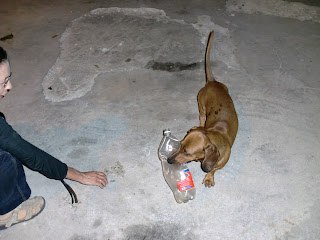Something in Common
The other night I watched a TV special discussing life in
Cuba. For many years travel to Cuba from
the US had been complicated by books full of rules, regulations, restrictions,
licenses, and authorizations. As a
result, US citizens stay away from Cuba in droves. As intriguing as the island might be to US
tourists, most decide it isn't worth the effort and travel somewhere else.
That's too bad as the island offers a large measure of
things to see and do as well as its own rich history, architecture, music, and
dance. 50 plus years of repressing
interaction between Cuba and the US have only served to make Cuba and its
culture more interesting. The TV special
I saw illuminated the many differences between life in the US and life in Cuba.
For an animal lover like me, one striking difference is the
number of dogs one encounters on the streets—that is, dogs without any
noticeable owners. Now, to be complete,
I have to say this is a Latin American and a Caribbean thing. Cuba
has fewer strays and homeless animals than say Honduras, but all the Latin
countries have far more than we are used to seeing in the US. Still, in Cuba few houses have fenced yards
for their pets (or any yards at all for that matter), and it is common to allow
your house pet to roam outside for its bathroom breaks. Also the use of collars and leashes is rare
in Cuba. Even owners on a walk with
their dogs depend upon the dogs staying with them while they stroll. Thus, some of the possible "strays"
one sees on the street are actually family pets and have homes. I have learned not to consider the absence of
an owner as evidence of homelessness.
That is to say, absence of evidence is not evidence of absence. Rather, I look at the dog's condition.
For me, the best evidence of homelessness is the condition
of the dog. Underfed, ribs showing,
lethargy, mange, etc. are far better indicators of homelessness. On the TV special I looked carefully for
street animals, I spotted two in the background of views of other subjects. Neither of these two showed any of the signs
of neglect, and I concluded these were someone's family dogs.
The TV special had sent its cameras and reporter into the
home lives and family lives of the Cubans, making evident the relative poverty
widespread in Cuba. Salaries are
miniscule and ration books supplement them, but ration books aren't sufficient
to provide all the needed food. Many
Cubans have sidelines, and everyone uses every opportunity to earn a little
extra money. One wonders how a person in
pressed circumstances can possibly have a dog in his family, and yet pets are
perhaps as common in Cuba as they are in the US. Dogs eat leftovers and scraps, slaughterhouse
offal and viscera. Chicken necks, pig
stomachs, kidneys, and whatever else can be purchased cheaply. Commercial pet food does not exist except in a
few tourist stores at unaffordable prices.
Nora Garcia, Aniplant's President, presents two radio shows and
one TV show each week. She teaches
animal care, animal health and humane practices. In a country where radio is as important as
TV is here, she has a large cadre of followers who tune into Radio Progresso every
Saturday at 9:30 am. Many times I've
seen her stopped on the street by passersby to respond to their questions about
pet care. These experiences help me to
conclude the typical Cuban loves animals as much as the typical American. They care for and love their pets and support
them despite meager resources. They show
up at spay neuter clinics for sterilization, knowing it is the long term
solution to stray animals on the street.
Even if they can't personally rescue all the strays, they help by
neutering their pets.
For all the differences in our lives and theirs, a love of
animals, however differently expressed, is something we have in common with our
island neighbors to the south.
Les Inglis































































































No comments:
Post a Comment